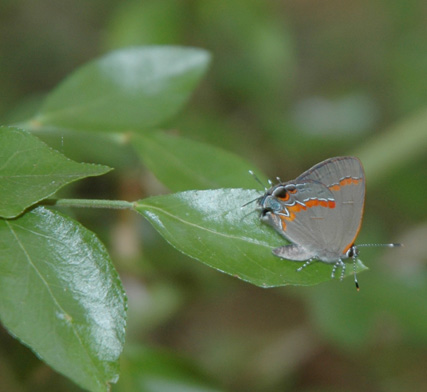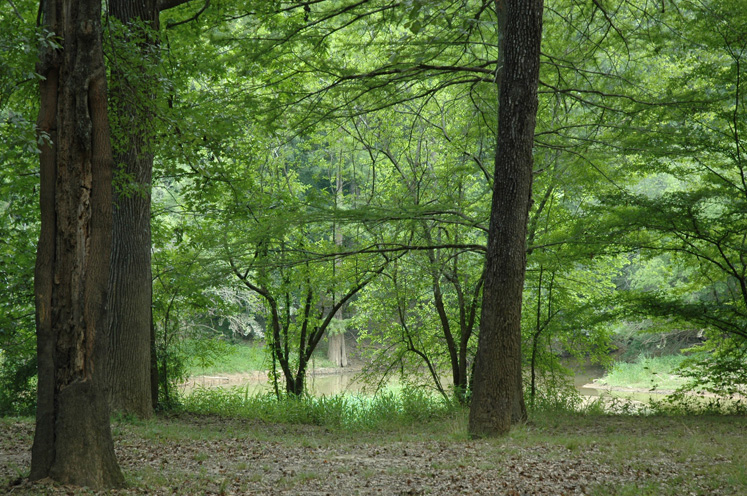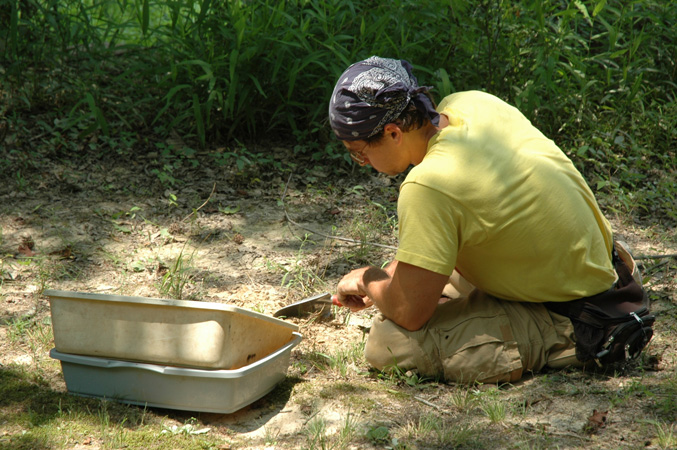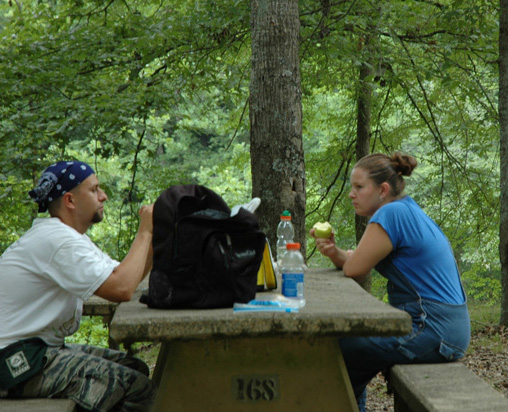Ants in Hugh White State Park/Grenada Lake, Grenada County, Mississippi, 12 June 2006
[MS State Park Ants]
Joe A. MacGown, JoVonn G. Hill, and Stephanie Larrick
Hugh White State Park is located on Grenada Lake in Grenada County, Mississippi five miles east of Grenada, off Mississippi Hwy. 8. This 1,581-acre park is centered around the 64,000-acre Grenada Reservoir and consequently, is a big draw for boating and fishing enthusiasts. The park has cabins, lots of improved camping spots, and a few tent camping sites. The park is split into two areas with most of the camping areas located near the Grenada Lake visitor center side of the lake and the other part of the park with the cabins being farther down Hwy 8. The lake itself is managed by the U.S. Army Corps of Engineers and includes several day use areas.
We arrived at Grenada Lake at about 9:45 and decided to start our collections at a picnic site (33°48'15"N 89°46'13"W) that was located beside the visitor center. At that point in time, we mistakenly thought we were in part of the state park, although we later realized that this was a Corps of Engineers site. Nevertheless, we collected there for about an hour. The picnic area itself was at the top of a hill overlooking the lake. There was quite a few scattered large trees, especially Quercus spp. present, that we baited with peanut butter. We collected Forelius mccooki (McCook), Camponotus decipiens Emery, Camponotus pennsylvanicus (DeGeer), and Crematogaster ashmeadi Mayr at the bait. Similar to many sites in the state, there was an abundance of imported fire ants, which, although fairly dark, were probably the hybrid, Solenopsis invicta X richteri. The only fire ant mounds we saw were inactive, which suggested that they had been poisoned. However, there were plenty of smaller colonies in the soil beside curbs, at bases of trees, etc. The black carpenter ant, Camponotus pennsylvanicus, was very common throughout this area crawling on the ground and on trees. Two other carpenter ant species, Camponotus decipiens ( a red and black ant) and Camponotus chromaiodes Bolton (blackish, with some reddish color in the mid portion), were also common here, although in lesser numbers. The only other species we noted in this area was Nylanderia vividula (Nylander), a ubiquitous species of roadsides and open areas. We searched the area for a while looking for Pheidole spp. nests, but had no luck. The diversity of ants in this area appeared to be quite low.

A red-banded hairstreak, Calycopis cecrops (Fabricius).
We then ambled down the steep slope toward the lake crossing the riprap until we reached a sandy area with some pockets of vegetation interspersed. In the harsh open sandy area, we didn't find any nesting species of ants, although we did see numerous beetles underneath various objects on the ground. As we walked to the far edge of the sandy area, there was more vegetation that led into a wet area. We found several scattered colonies of the extremely fast moving, yellowish-red, Dorymyrmex bureni (Trager) and another fast moving species, Forelius mccooki, in this area. Both of these dolichoderine ants are commonly found in open areas. Sweeping the vegetation yielded little in the way of ants, and we were disappointed that we didn't find any of the elongate, stem inhabiting Pseudomyrmex species there. Beating limbs of trees, vines, and shrubs was similarly disappointing.
We continued on across the sandy area and reached a steep wooded hillside that led to a day use area. One litter sample was collected from this wooded ravine. Only four additional species were found in the litter sample: Tapinoma sessile (Say) (the odorous house ant), Brachymyrmex depilis Emery, Strumigenys louisianae Roger, and Pheidole dentata Mayr. These are all very common species, although Strumigenys are very cool looking little ants with their impressive elongate mandibles.
We felt like we had a pretty good idea of what was going on here, so we headed back to the picnic area to go visit another site. Before going on, we went in to the visitor center, where we obtained a map of the lake region. It was then that we realized that we were not actually in the state park. Despite this, we went back down the road and collected in another non-state park site, the Lost Bluff Hiking Trail (33°47'53"N 89°46'07"W). This hilly trail led through a mixed pine-deciduous forest with one branch of the trail leading to the remnants of a historic civil war fort. All that is left now of the fort is a ring of dirt on a hill, but apparently this fort, along with 5 others surrounding Grenada, once stood as a defense system keeping Union soldiers from crossing the Yalobusha River and entering the city of Grenada. We didn't spend much time at this site as we wanted to go collect in the state park itself. However, we did collect several species here including Nylanderia faisonensis (Forel), Nylanderia parvula (Mayr), Camponotus americanus Mayr, C. chromaiodes, C. pennsylvanicus, Formica dolosa Buren, F. pallidefulva Latreille, Trachymyrmex septentrionalis (McCook), Monomorium minimum (Buckley). Solenopsis invicta X richteri, Solenopsis sp. cf. molesta (Say), Aphaenogaster carolinensis (Wheeler), Pheidole dentata, Crematogaster ashmeadi, and Temnothorax pergandei Emery.
We next went to the part of the state park that was nearest the visitor center. The folks at the entrance appeared to be quite interested in what we were doing and mentioned that a couple of different kinds of carpenter ants were common in the park. The first part of the park was just an open grassy habitat, which bordered the river channel. Apparently a circus of some sort had just been set up in this area, and all of the trucks with the various rides were still present. The entire border of the lake here was full of people, with their trucks, boats, and campers. It looked to be a very popular site. We drove through the entire campsite area, which was in mostly deciduous forest and bordered the channel. We were looking for an area where we wouldn't disturb anybody and could collect with abandon. However, all of the improved sites appeared to be filled. It wasn't until reaching the end of the road where the few tent pads were located that we found an isolated spot to collect (33°48'08"N 89°47'11"W). As it turned out, nobody was camping (go figure-nobody in tents in mid June in Mississippi). This site also was the best habitat we had seen in the park with lots of large hardwood trees and sandy soil, so we decided to stay here and collect a while. The campsites bordered what appeared to be an old channel of the river on one side and the main channel on the other. At the far end of the camping area, the woods were more mixed with lots of large loblolly pines present.

The primitive campground.
Before collecting we ate our lunch at one of the picnic tables. It was strange fare to say the least with water, sardines, various breakfast type bars that had been in a backpack for who knows how long, and bananas (Stephanie, being more cultured, actually had a sandwich and an apple). After our sumptuous feast we baited some of the larger oaks with peanut butter, which attracted Camponotus pennsylvanicus, Camponotus snellingi, and Temnothorax schaumii Roger. It is always nice to find the cryptic T. schaumii, and peanut butter on oaks is a great way to lure them in. Several of this species was also found in some litter at the base of an oak tree. We then started looking around for foraging ants. The first thing we noticed were the presence of many colonies of Lasius americanus Emery in the soil. Forelius mccooki, Formica pallidefulva, Solenopsis invicta X richteri, and Pheidole bicarinata Mayr were also found nesting in the soil. One colony of F. pallidefulva was found nesting in some grass clippings at the base of a stump. There seemed to be plenty of activity in these grass clippings, so a bag of it was scooped up for later Berlese extraction. This resulted in the collection of three additional species, Hypoponera opacior (Forel), Monomorium minimum, and Solenopsis sp. cf.molesta. Vegetation along the river channels was swept, in hopes of obtaining stem dwelling species, but none were found.
JoVonn and Stephanie eating lunch.
After collecting in the open hardwood area for an hour or so, we then collected in an adjacent piney area . There were numerous rotting pines on the ground as well as several dead pines that were still standing. Three species of carpenter ants, C. chromaiodes, C. pennsylvanicus, and C. snellingi, were in abundance here. Several colonies of Aphaenogaster lamellidens were seen in a rotting wood. One of them, discovered under bark of a dead loblolly pine. was quite large and contained workers, alate females, alate males, and brood. Three other Aphaenogaster species were also found in these woods, A. carolinensis, A. fulva Roger, and a very dark, almost blackish species that appeared to be A. miamiana Wheeler, a species we typically find farther south, but have found in the Misisissippi Delta as well. Several other species were found in the pine litter in the area including Nylanderia faisonensis, Ponera pennsylvanica Buckley, Pheidole dentigula Smith, Crematogaster ashmeadi, Temnothorax curvispinosus Mayr, and Myrmecina americana Emery. Four bags of leaf litter were collected from the mixed forest from bases of pines and beside rotting logs. Many of the species collected in this area were also in these litter samples, but some other rather interesting species were found in there including Ponera exotica Smith, Discothyrea testacea Roger, Proceratium silaceum Roger, Strumigenys angulata Smith, and Strumigenys louisianae. All of these denizens of the soil and leaf litter world were once considered rare, but now are found regularly thanks to the Berlese funnel method of extracting them the samples.

JoVonn, collecting ants on a tree.
Sometime around 2:00 P.M. we left this side of the park and headed over to the cabin area. The entrance road was very long and we were beginning to wonder if we had taken the wrong road. We eventually passed a new looking golf course, then we saw a trail sign off to the left entitled "Little Mountain hiking trail". Figuring we were on the right road we kept driving and subsequently found the gate house to the park. No one was present, so we continued on until we saw signs for the office. We made our way to the office and let them know what we were doing. We asked about hiking trails and the lady working there said there was only one and it had been severely shortened due to the golf course construction. We thanked her for the information and then drove around a bit. We went down to the boat launch area where there were very few camp spaces hoping to find a good collecting spot. But, we decided not to collect there and instead ventured back to the Little Mountain hiking trail (33°48'01"N 89°43'49"W).

Beginning of Little Mountain Hiking Trail
We parked in a sandy area and upon exiting the vehicle, we immediately saw ants. Workers of the relatively large Aphaenogaster treatae Forel were collected at the edge of the parking area. Of course, the ever present imported fire ants were present. In the same general area colonies of the fungus cultivator, Trachymyrmex septentrionalis, were found. We then continued up the steep trail, which rose steeply to around 400 ft and wound through mostly deciduous forest until culminating in a mixed pine-hardwood forest at the top. The trail itself proved to be ideal habitat for several species of ants including Trachymyrmex, of which we saw many colonies. One colony was observed for several minutes as workers carried what appeared to be insect feces and other bits of vegetative matter into their colony. This particular colony was nestled up against a piece of timber that served as a step. Side by side with the fungus ant colony was a colony of Pheidole dentata Mayr. This colony was in the soil and extended into the wood of the step. Workers of this species roamed freely through the area inhabited by the Trachymyrmex and there appeared to be no obvious interaction between the two species.
Similar to the campground area, this site had plenty of the black carpenter ant, C. pennsylvanicus, and Lasius alienus running about. Another black carpenter ant species, C. nearcticus Emery, was collected at this site. This species is much shinier and somewhat smaller than C. pennsylvanicus. Temnothorax pergandei was also seen to be very abundant here. Another species of Lasius, L. umbratus (Nylander), was found in the litter at the top of the trail. This yellow species is quite different looking than the dark brownish-black L. alienus that was more common along the lower portions of the trail. Some other common species were collected in the litter layer including Nylanderia faisonensis, N. parvula (Mayr), Prenolepis imparis (Say), Hypoponera opacior, Ponera pennsylvanica, Solenopsis sp. cf. molesta, Aphaenogaster fulva, A. lamellidens, Crematogaster lineolata (Say), Temnothorax curvispinosus, and Myrmecina americana. Although Nylanderia faisonensis is a ubiquitous ant in many forested habitats in Mississippi, N. parvula is only found occasionally. Prenolepis imparis, which is related to Nylanderia, is typically found in the colder months and only a few individuals were seen. Undoubtedly, this area will be over run with them by Fall. The two species of Aphaenogaster that were collected in the litter typically nest in rotting wood and it is likely that the specimens we collected were foraging workers.
Several colonies of the beautiful Pheidole metallescens Emery were discovered nesting in the sandy soil of the trail. Like our other Pheidole species, workers of this species are dimorphic and have major and minor workers. The minor workers are tiny, blackish colored ants that have bluish-green coloration when viewed under a microscope. This species is typically encountered only in sandy soils. The little black ant, Monomorium minimum, was also found nesting in the soil on the trail. An untrained eye could easily mistake this common species with the more resplendent, P. metallescens, due the minor workers appearing black from a distance.
As we journeyed to the top of the trail, we collected soil and leaf litter samples and ended up with a total of 12 gallons of litter, which we took back to the lab for Berlese funnel extraction. The soil was extremely dry here, as elsewhere in the region, due to lack of any substantial rainfall for the last month or so. We were somewhat concerned that this would affect our ant collections. But, even as we collected litter samples, we noticed ant activity. Many of the ants collected from the litter samples included species that we had collected by hand, and only three additional species were collected including Strumigenys angulata, S. ornata Mayr, and Strumigenys louisianae. All three of these species are cryptic litter dwelling dacetine ants, and litter sampling is a great way to find them.

Joe, digging into a Lasius colony.
Although the area was very dry due to lack of any substantial rainfall, we still managed to get a fairly large number of ants at the state park and adjacent Grenada Lake visitor center area. A total of 45 species were collected overall with representatives from five different subfamilies. Only six of the total species were not collected within the confines of Hugh White State Park itself including Dorymyrmex bureni, Tapinoma sessile, Brachymyrmex depilis, Nylanderia vividula, Camponotus americanus, and Formica dolosa. However, all of these species are very common and are likely found in the park because it shared the same habitat with the adjacent Corps of Engineers land. In fact, with further time and with collecting forays made at different times of the year, the list of ants from this area would likely be much higher. The carpenter ant genus, Camponotus, had the most species represented with six, followed by Aphaenogaster with five. This was to be expected in a heavily wooded environment, because both of these genera typically nest in rotting wood, or in litter that is found in wooded habitats. The dacetine ants were relatively poorly represented however, with only three species collected. Considering the large number of litter samples we collected, this was somewhat surprising. The poor representation of this group, which includes Strumigenys, our largest genus in the state, may be attributable to the extremely dry conditions. Typically, we have better luck finding these ants when the soil is more moist. Perhaps they may nest deeper in drier times. The most interesting species we found were Lasius umbratus, Ponera exotica, Discothyrea testacea, Proceratium silaceum, and Strumigenys angulata. Although Lasius umbratus and P. silaceum are not considered to be rare species, there are infrequently collected in the state, and we are always glad to find them. Ponera exotica was considered to be very rarely collected species not too many years ago, but is now known to be much more common in the southeastern U.S. Strumigenys angulata was also considered to be a rare species, and is not known to be widely distributed in the U.S., but recent collections by the Mississippi Entomological Museum has shown that it is found throughout Mississippi in many forested habitats. Discothyrea testacea is another species that was formerly considered to be rare in the U.S. before the advent of Berlese funnels and other similar soil and litter extraction devices and was only recently discovered to occur in Mississippi (MacGown and Brown, 2006).
List of ant species collected (arranged alphabetically by genus)
Aphaenogaster carolinensis (Wheeler)
Aphaenogaster fulva Roger
Aphaenogaster lamellidens Mayr
Aphaenogaster miamiana Wheeler
Aphaenogaster treatae Forel
Camponotus americanus Mayr
Camponotus chromaiodes Bolton
Camponotus decipiens Emery
Camponotus nearcticus Emery
Camponotus pennsylvanicus (DeGeer)
Camponotus snellingi Bolton
Brachymyrmex depilis Emery
Crematogaster ashmeadi Mayr
Crematogaster lineolata (Say)
Discothyrea testacea Roger
Dorymyrmex bureni (Trager)
Forelius mccooki (McCook)
Formica dolosa Buren
Formica pallidefulva Latreille
Hypoponera opacior (Forel)
Lasius aphidicola (Walsh)
Lasius americanus Emery
Monomorium minimum (Buckley)
Myrmecina americana Emery
Nylanderia faisonensis (Forel)
Nylanderia parvula (Mayr)
Nylanderia vividula (Nylander)
Pheidole bicarinata Mayr
Pheidole dentata Mayr
Pheidole dentigula Smith
Pheidole metallescens Emery
Ponera exotica Smith
Ponera pennsylvanica Buckley
Prenolepis imparis (Say)
Proceratium silaceum Roger
Solenopsis invicta X richteri
Solenopsis sp. cf. molesta (Say)
Strumigenys angulata Smith
Strumigenys louisianae Roger
Strumigenys ornata Mayr
Tapinoma sessile (Say)
Temnothorax curvispinosus Mayr
Temnothorax pergandei Emery
Temnothorax schaumii Roger
Trachymyrmex septentrionalis (McCook)
Literature Cited
MacGown, J. A. and R. L. Brown. 2006. Survey of Ants (Hymenoptera: Formicidae) of the Tombigbee National Forest in Mississippi. Kansas Entomological Society 79: 325-340. [pdf]



